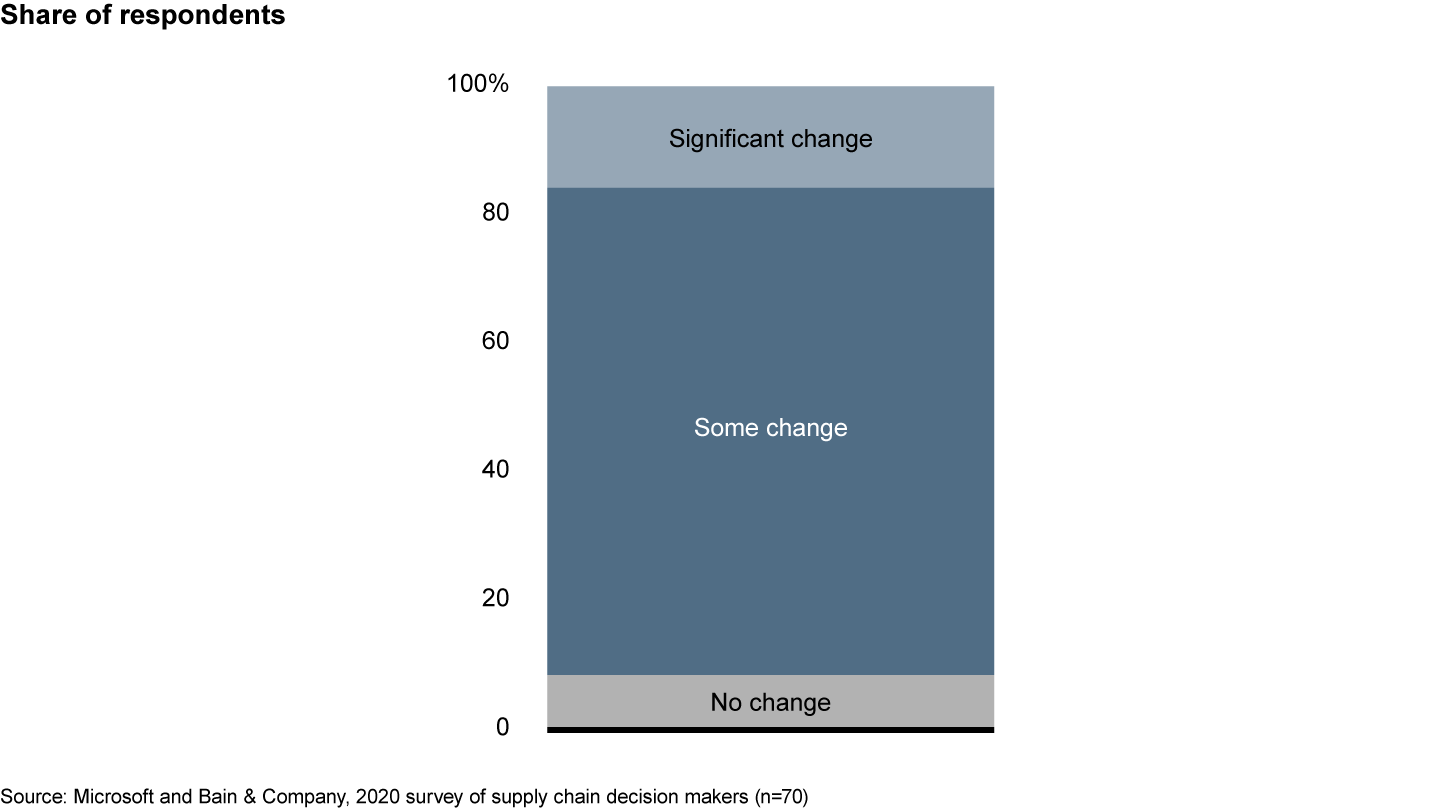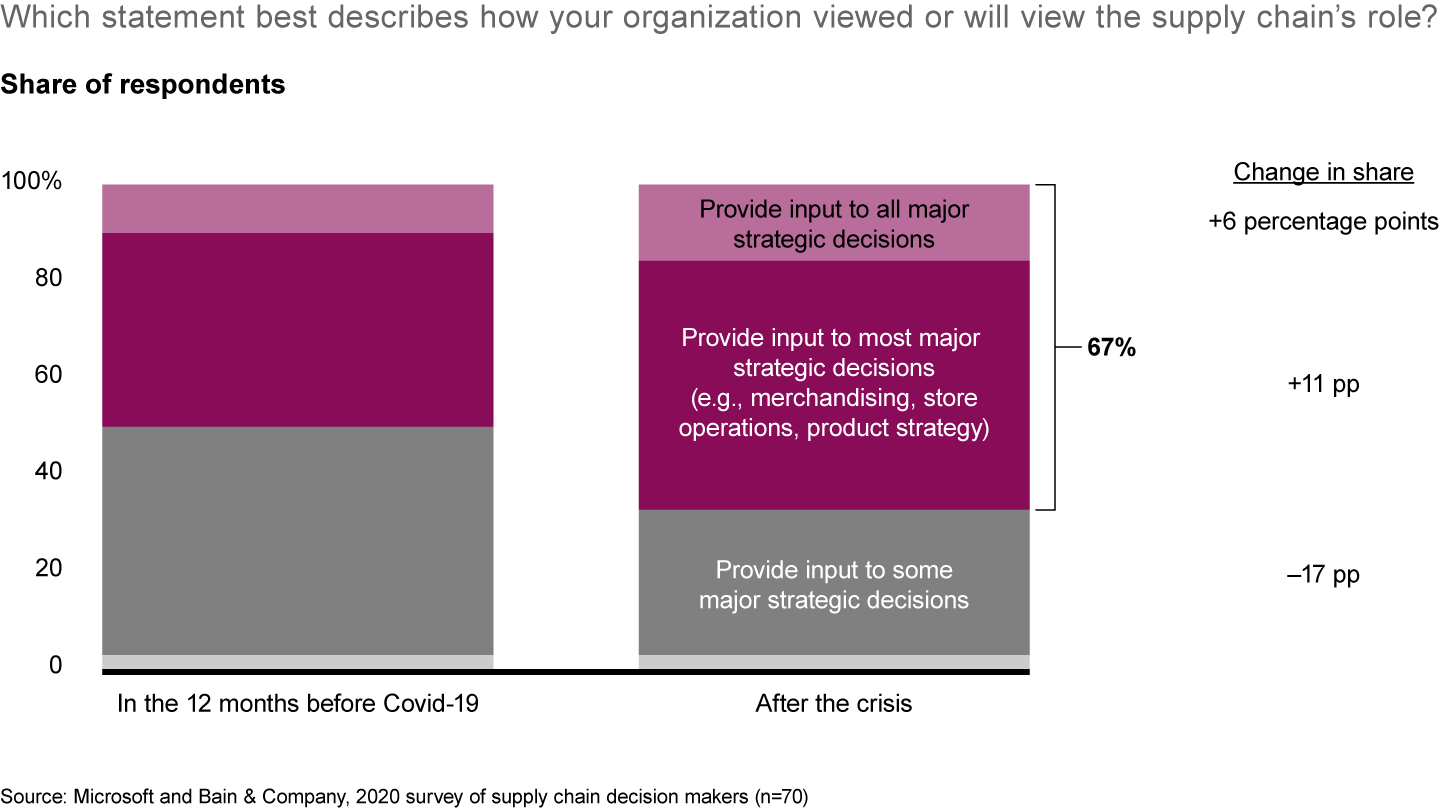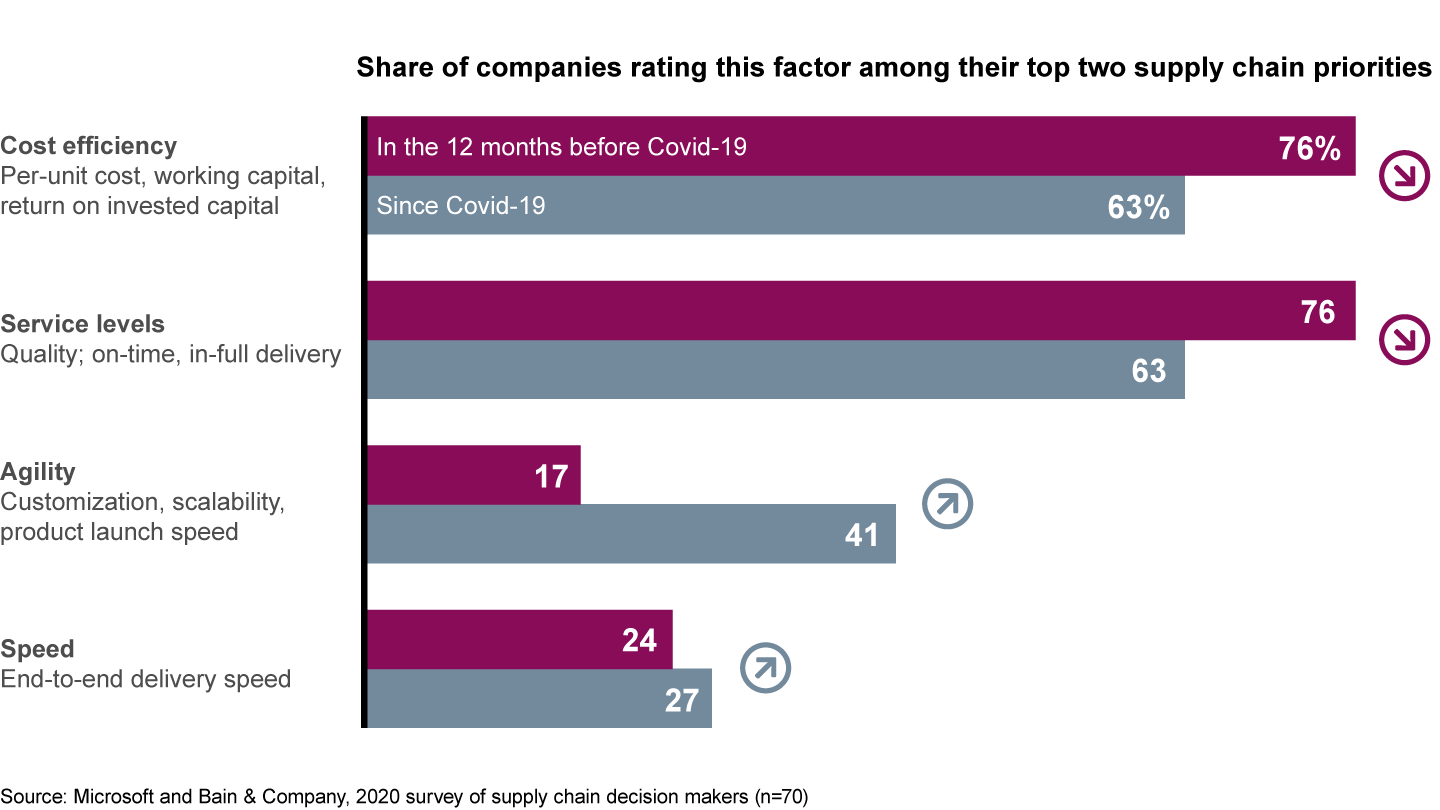Brief

한눈에 보기
- More than 40% of US companies plan to increase their total supply chain investment.
- Many senior executives now view their supply chains as a strategic capability instead of a cost center.
- Post–Covid-19, 67% of retailers and consumer goods companies expect supply chain managers to provide input to most or all strategic decisions.
Covid-19 has wreaked havoc with global retail and consumer goods supply chains, exposing a critical shortcoming. Companies with supply networks designed for maximum cost efficiency were unable to respond quickly to sudden supply shocks and demand spikes. The prize of efficiency came at the cost of resilience.
Disruption has hit supply chains at a moment of rapid change for the industry. Even before the pandemic, retailers and consumer goods companies were grappling with a dramatic rise in customer expectations. Big retailers like Amazon and Walmart have been steadily raising the bar on the speed of shipping, adding to the urgency to improve network speed and agility.
Written in collaboration with
Written in collaboration with

Leadership teams are now moving quickly to rebalance their worldwide networks. Many are also considering whether to exit China or reduce their dependence on far-flung suppliers. For senior executives, supply chains have gained new strategic meaning. To better understand how Covid-19 is transforming the retail and consumer goods networks, Bain joined forces with Microsoft to examine supply chain–related investment plans and priorities at 70 US companies and to explore executives’ shifting perceptions of how supply chains affect business success.
Our research revealed three critical changes in retail and consumer goods supply chain management. The most striking is a new willingness among senior executives to make trade-offs between cost, speed and resilience. Many who once viewed their supply chain as a cost center now see it as a strategic capability. Of the companies we surveyed, just over 90% plan changes to their supply chain networks, including supplier location, flexibility and overall footprint (see Figure 1). And more than 40% expect to increase their total supply chain investment with the primary goal of improving speed, agility and resilience.


In a second key shift, retail and consumer goods leadership teams are starting to include top supply chain managers in strategic decision making, acknowledging that supply chain data and insights are vital to their business success. Of the companies we surveyed, 67% expect their supply chain organizations to provide input to most or all major strategic decisions, such as merchandising, store operations and product strategy—an increase of 11 percentage points over the 12-month period prior to Covid-19 (see Figure 2).


Third, we found that these companies are focusing investments in three important areas to bolster supply chain speed and agility: omnichannel fulfillment, predictive planning and flexible operations.
While many of the companies we surveyed said they are confident about transforming their supply chains for a new era, they are also grappling with a number of obstacles that may slow progress. Forty percent of respondents admitted they did not yet have the internal solutions or external partners they need to achieve their goals. And many lack the resources to invest in resilient supply chains.
Below we take a closer look at these three critical supply chain trends, how leading retail and consumer goods companies are implementing change, and steps executive teams can take to improve resilience.
Speed, agility and resilience
Well before Covid-19, as they grappled with increasing customer expectations and a series of disruptions from natural disasters and escalating trade barriers, retail and consumer goods leaders were beginning to see the limitations of their cost-efficient yet rigid supply chains. When the pandemic paralyzed global supply chains, it concurrently triggered a massive surge in online sales—a double shock that few retailers and consumer goods companies were prepared to handle. Many companies, for example, struggled to adapt when employees were forced to work from home. Some had operating models that allowed them to quickly train and redeploy idled workers to other crucial areas, such as moving retail-store floor employees to e-commerce fulfillment roles. But many others floundered. Nowhere was the lack of resilience more obvious than in supply chains.
Boards and executive teams are now taking a hard look at the lessons learned.
Traditional supply chain management has been all about streamlining, but the pandemic exposed the risk of a narrow focus on cost efficiency at the expense of customer convenience, concentrating supply with one or two large sources and limiting buffer capacity. Our study shows that the share of executives rating cost efficiency as one of their top two supply chain goals fell by 13 percentage points, while agility rose by 24 percentage points (see Figure 3).


The cost of agility and resilience is a distributed set of suppliers and operations. It also includes investment in technology that gives companies a high degree of transparency past tier 1 suppliers, all the way back to tiers 2, 3 and 4. Redundancy often seems expendable—until it isn’t.
Successful retailers and consumer goods companies have started constructing flexible networks of suppliers and manufacturing partners. That means setting up alternative suppliers, manufacturing sites and assembly nodes; multiple customer fulfillment options; and forward deployment of inventory. They also make the most of Industry 4.0 tools to optimize costs, improve visibility across the network and accelerate reaction times.
As they take those steps, leadership teams are making critical trade-offs between efficiency, convenience and responsiveness to improve resilience. One simple example is determining how full a truck needs to be before it leaves the distribution center for the store. Filling it to capacity is efficient, but sometimes it takes an extra day to fully load, delaying its arrival at the retail store. The push for maximum efficiency often undermines agility.
Strategic input
As they start down the path of recovery from Covid-19, leadership teams around the world are rapidly reassessing just how vital supply chains are to their companies’ success. Until recently, supply chain managers have largely acted as order takers, delivering goods from merchants to warehouses or stores at the cheapest cost per mile. To minimize future supply shocks, many retailers and consumer goods companies now plan to give their supply chain managers a greater role in strategic decision making. Some already have begun incorporating supply chain data and insights into business strategy.
The reason is clear. Resilience requires piercing the veil that shrouded yesterday’s supply chains. Leading retailers and consumer goods companies are using cloud-based supply chain applications and other tools that can share information with their networks of suppliers and partners. During the Covid-19 crisis, many manufacturers demanded greater visibility into their suppliers’ own supply chains—a practice worth continuing.
Likewise, “control tower” solutions that integrate data across the entire supply chain, along with 5G technology and blockchain, offer leadership teams real-time visibility and allow them to calibrate supply and demand during normal times, as well as react to supply and demand shocks. The ability to compare production capacity with real-time demand signals will be critical to weathering future supply chain shocks.
To ensure their supply chain teams contribute effectively to strategic decisions, leaders are updating roles, responsibilities and accountabilities, and managing change across the organization. Buyers and merchants at retail companies, for example, traditionally have had total autonomy in deciding which goods to purchase, in what volumes and in what packaging, whether it’s 50 jars per box or 10 jars. But those decisions can undermine supply chain speed or cost efficiency.
A supplier’s recommendation to take larger pack sizes or quantities in a shipment, for example, may end up increasing retailers’ supply chain costs and slowing deliveries. Some stores may not be able to use 50 jars of an item, forcing the retailer’s supply chain team to break the large pack open and repackage it into smaller quantities, adding costs that outweigh the savings of purchasing a larger pack size. Forward-looking retailers are making sure buyers coordinate with supply chain managers so that their decisions won’t result in hidden costs.
Three key capabilities
As they start to rethink their supply chain networks, retail and consumer goods companies are targeting three key capabilities to improve responsiveness and speed: omnichannel supply management, predictive planning and flexible operations (see Figure 4). All three capabilities were important before Covid-19, and now they have become critical to cope with an ongoing surge in online sales.


Omnichannel fulfillment. Traditionally, retailers and consumer goods companies have relied on large, centralized facilities to fulfill online orders efficiently. Even before Covid-19, retailers faced growing pressure to fulfill digital orders faster. Our research shows that nearly 60% of retailers and consumer goods companies now plan to increase their investment in multiple facilities that can respond to online orders.
Take the example of Target, which has begun using its more than 1,800 US stores as mini fulfillment hubs that can respond faster to online orders than a central fulfillment center. That shift, accelerated during the pandemic, helped Target sustain sales during the lockdown despite store closures. In April, Target’s digital sales rose 282% year over year, with stores fulfilling 80% of digital orders. And using stores as fulfillment centers is up to 40% cheaper than shipping from a central warehouse, the company says.
Target and others also are integrating in one facility their distribution centers, which handle bulk orders from retailers or wholesalers, and fulfillment centers, which process orders to individuals. Target’s goal is to reduce the replenishment cycle in stores from days to hours and to cut store inventory levels. That means sending shipments to stores more frequently and in smaller lots to more precisely match demand, instead of shipping big cases of products. The shift allows Target to expand its use of stores to fulfill online orders while lowering inventory levels at the same time.
Predictive planning and demand forecasting. To improve supply chain resilience, retailers and consumer goods companies need better visibility into network constraints and bottlenecks, as well as additional channels to avoid blockages. That means understanding real-time consumer demand and anticipating where, geographically, demand is likely to crop up. For instance, will major sporting events create short-term demand spikes for beverages and snacks? Our findings show that 56% of retail and consumer goods companies plan to increase investments in predictive planning and demand forecasting.
Several leaders already are using predictive planning and demand forecasting tools to dramatically improve their performance. A large European retailer invested in artificial intelligence technology prior to Covid-19 to tackle the twin problems of overstocking and understocking. By modeling customer behavior in every store, the company was able to reduce stock outages by 30%, reduce in-store stockholding by two to three days, boost sales, and reduce waste and markdowns. Those gains increased the retailer’s profitability by reducing missed sales and improving product assortment.
Another global consumer goods company with a majority of sales in highly perishable categories used demand forecasting to deliver significant gains in the efficiency of its ordering process. Advanced analytics and machine learning tools helped improve forecast accuracy by up to 50%. Artificial intelligence technology reduced product waste by 40% to 50% and improved frontline driver time by 50%.
Flexible operations. To weather future supply and demand shocks, leading retailers and consumer goods companies are seeking to boost supply chain flexibility. Many are teaming up with partners to speed fulfillment and delivery. Our research shows that 53% of retailers and consumer goods companies are planning to increase investments in flexible operations.
Walmart, for instance, has partnered with several companies, including DoorDash, to get items to customers quickly. The giant retailer also has launched a pilot with grocery delivery platform Instacart to offer same-day service to four markets in California and Oklahoma. Customers will be able to have thousands of items, including groceries, alcohol, personal care products and electronics, brought to their doorsteps in as little as one hour.
And, like other retailers, Walmart is innovating in last-mile fulfillment. It partnered with Bringg to launch Spark Delivery, an in-house platform for crowdsourced last-mile fulfillment. Target, meanwhile, acquired Shipt to enable same-day delivery to most of the US and purchased Deliv’s proprietary technology to help make deliveries faster and cheaper.
Overcoming obstacles
As retail and consumer goods companies set out to improve their supply chain resilience, many are confronting a new set of challenges. Merchants may object to new decision-making models. Their own data systems may be archaic, making it difficult to improve supply chain visibility. Supply chain managers may need coaching to bring strategic insights to the table, and leadership teams will need to incorporate new data sets and metrics into decision making. Talent and partners are also in short supply, which increases the difficulty to adapt.
Successful retailers and consumer goods companies address potential obstacles before implementing a supply chain transformation. One approach is to set up an inventory steering committee that meets regularly to determine which inventory is top priority and resolve conflicts that may arise between supply chain best practice and buyers’ efforts to purchase goods at the lowest possible price.
One large US retailer, for example, used inventory analytics to understand the root causes of poor availability, excess inventory and high supply chain costs. A key problem: Managers in different functions with different objectives were making decisions that significantly affected supply chain costs and speed. As the leadership team overhauled its inventory strategy, it set up a decision forum across merchandising, supply chain, store operations and IT to ensure future decisions were aligned with the firm’s long-term goals. That approach helped deliver a 12% increase in sales from improved availability and an 11% drop in excess inventory—without increasing total supply chain costs. It also generated a 30-percentage-point improvement in on-time, in-full supplier deliveries.
Monday morning, 8 AM
Covid-19 has created a sense of urgency for change, and successful companies are looking to invest in the right capabilities for the long term. Leadership teams can get started on rethinking their supply chains by answering a few high-gain questions:
- What are the implicit trade-offs in your supply chain? Where have you cut cost but potentially slowed network speed and reduced your ability to respond to system shocks?
- What end-to-end data should you be collecting in real time, and how can the organization make the best use of that data?
- What kind of omnichannel experience do your customers want, and how can the supply chain meet their expectations?
- Where are the gaps—in technology, talent and partners—that you need to address to make your supply chain more resilient?

About Microsoft
Microsoft (Nasdaq “MSFT” @microsoft) enables digital transformation for the era of an intelligent cloud and an intelligent edge. Its mission is to empower every person and every organization on the planet to achieve more.